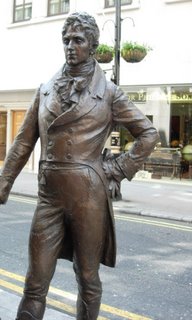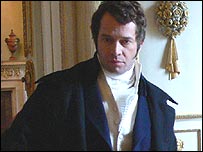 In three weeks — on Tuesday, September 26 — I’ll be holding a contest here, with great prizes. So, do you want to hear about the contest first, or the prizes?
In three weeks — on Tuesday, September 26 — I’ll be holding a contest here, with great prizes. So, do you want to hear about the contest first, or the prizes?
The prizes? Okay!
There will be at least two winners, and they will have a variety of prizes to choose from. The first winner will get to choose any of these prizes she or he wishes — and the second will choose from the remaining prizes. (If there are a lot of entrants, I’ll have a third winner too!)
PRIZE A: PRIDE & PREJUDICE “FOR YOUR CONSIDERATION” Book. This is an 11″ by 9″ softcover book with approximately 80 pages of color photos of last year’s film of “Pride and Prejudice.” This was the book given to Academy members to convince them to nominate everyone who worked on the film, and I suspect it’s pretty rare. As well as laudatory critical quotes, it has lots of neat bits: quotes from the production designer on her aims, from Keira Knightley on her thoughts about taking the roles, several excerpts from the script, costume designs, a picture of Sleeveless Hussy (Miss Bingley) in her sleeveless dress,  and a lot more. And yes, all you Matthew MacFadyen fans — there are very nice pics of him in it. (The picture at the top of this post is the cover.)
and a lot more. And yes, all you Matthew MacFadyen fans — there are very nice pics of him in it. (The picture at the top of this post is the cover.)
PRIZE B: BATH MUSEUM OF COSTUME & ASSEMBLY ROOMS souvenir guidebook. This 8″ by 11 1/2″ “Authorised Guide” has 48 pages of pictures of the Assembly Rooms in Bath, descriptions of their history, and photos and explanation of the famous Costume Museum Collections there, accompanied by period illustrations.
PRIZE C: An Advanced Reading Copy of Stephanie Barron’s sixth Jane Austen mystery, JANE AND THE PRISONER OF WOOL HOUSE, which came out in 2001.
 PRIZE D: Hardback copy of Steven Parissien’s GEORGE IV: INSPIRATION OF THE REGENCY. Four hundred pages about the Prince Regent himself, including sixteen black-and-white plates, this book was called “Charming, intelligent, imaginitive, witty” by the Sunday Times.
PRIZE D: Hardback copy of Steven Parissien’s GEORGE IV: INSPIRATION OF THE REGENCY. Four hundred pages about the Prince Regent himself, including sixteen black-and-white plates, this book was called “Charming, intelligent, imaginitive, witty” by the Sunday Times.
PRIZE E: Any four of the following paperbacks: Georgette Heyer’s THE MASQUERADERS; Georgette Heyer’s SYLVESTER; Carla Kelly’s SUMMER CAMPAIGN;
Carla Kelly’s MISS CHARTLEY’S GUIDED TOUR; Carla Kelly’s LIBBY’S LONDON MERCHANT; Catherine Fellows’s THE LOVE MATCH; Laura Kinsale’s FOR MY LADY’S HEART (It’s Medieval, not Regency, but it’s a Kinsale!); and Patricia Wrede’s MAIRELON THE MAGICIAN (which is fantasy set during the Regency.) Information about the condition or edition of any of the above available on request, beginning next week (September 12). (Some have well-creased spines. Some don’t.)
Those are the prizes. Now — for the contest.
Because my book (MY LADY GAMESTER) is still in print, but may not be for long, I’m making this contest all about it! To enter, you will need to read MY LADY GAMESTER (author: Cara King) by Tuesday, September 26. (I will not ask how you obtain it — new, used, library, friend — but I will mention that it is still available new through Amazon and similar outlets.) 
Then on Tuesday, September 26, there will be a discussion about the book here, on the Risky Regencies blog. If you leave a comment that makes any kind of sense and shows you’ve actually read the book, your name will be entered two times in the drawing. For each further sensible comment, you will have one more entry. (Please note: you don’t have to say nice things about the book. Honest discussion is what is sought.) Then names will be drawn at random — first name drawn gets first choice from prizes A – E, and second name gets second choice. (If there are a lot of comments, I’ll have a third winner as well.)
You can start placing comments at 12 a.m. Pacific Time (3 a.m. Eastern Time, 8 a.m. GMT) the morning of Tuesday, September 26, and place them as late as noon Pacific time (3 p.m. Eastern Time, 8 p.m. GMT) the following day, Wednesday, September 27, 2006.
And, yes — I will mail these prizes anywhere in the world (except for the GEORGE IV book, which is just too heavy). So no matter where you’re living, you’re eligible.
If you have any questions about the contest, ask them here — but please be patient about the reply. I’m off to England today to see six plays in six days — including five of Shakespeare’s most rarely performed plays — so I’ll be offline much of the next week. (The plays, if anyone’s interested, are the three Henry VI plays [all in one day!], King John, and Troilus and Cressida. Plus the new Stoppard.)
So: why should you enter? (a) You may win great prizes;  (b) If this contest gets a lot of comments, we’ll probably have other similar contests in the future, with even more great prizes; (c) You might just enjoy reading the book; and (d) Even if you don’t, it should be fun explaining why not to everyone else who’s read it!
(b) If this contest gets a lot of comments, we’ll probably have other similar contests in the future, with even more great prizes; (c) You might just enjoy reading the book; and (d) Even if you don’t, it should be fun explaining why not to everyone else who’s read it!
So, one final point… The answer to the question “Is a contest in which an author forces entrants to talk about her book a sign of (a) runaway egomania, or (b) rampant insecurity?” is still being debated in Parliament.
Cara
Cara King — author of MY LADY GAMESTER
Booksellers’ Best Award for Best Regency of 2005
 Every day I don’t write I go a little crazy. I make excuses, that I’m dealing with more important things like my children’s health and well-being or major or minor household catastrophes, but something inside me screams. If I ignore it the screams build up in the pit of my stomach and somewhere between my shoulderblades. It gets physical.
Every day I don’t write I go a little crazy. I make excuses, that I’m dealing with more important things like my children’s health and well-being or major or minor household catastrophes, but something inside me screams. If I ignore it the screams build up in the pit of my stomach and somewhere between my shoulderblades. It gets physical.













